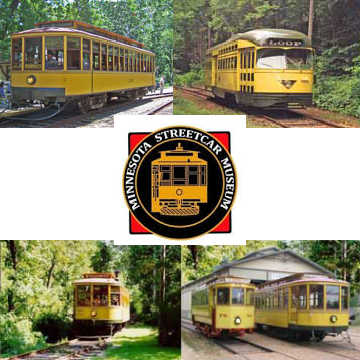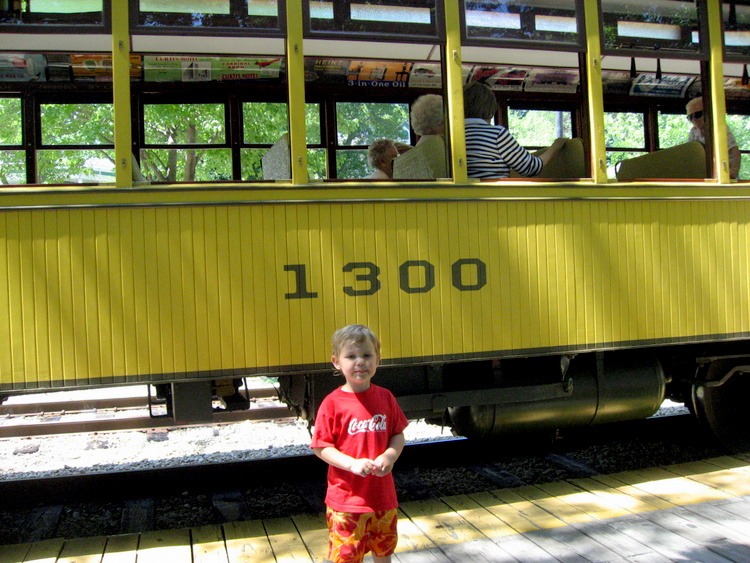Climb on board the Trolley! Founded in 1962, today’s kids still love the Minnesota Streetcar Museum (“MSM”)! Rather than a traditional brick and mortar building, this museum is a collection of restored, historic streetcars. These mini museums on tracks are active and operational trolleys that run at select times between May and October each summer. Passengers can see the Linden Hills neighborhood and Lake Harriet as they ride around in one of the last streetcars still in service. Minnesota Streetcar Museum was originally part of the broader Minnesota Transportation Museum, but in December 2004 it became its own entity when MTM restructured to focus primarily on railroading. Currently, the museum maintains a fleet of eight historic Minnesota streetcars at the Como-Harriet Streetcar Line in Minneapolis and the Excelsior Streetcar Line, which operates in Downtown Excelsior near Lake Minnetonka (←we maintain a separate directory page for the Excelsior Line). Much of the museum’s equipment comes from Metro Transit’s predecessor, Twin City Rapid Transit. However, the museum represents street car history for all of Minnesota, and some of the equipment also originated in Duluth-Superior and Winona. April 29 – May: Weekends 12:30 to 8:30 PM June through August: September: Weekends 12:30 to 7:30 PM October 1 through 22: Weekends 12:30 to 4 PM The museum hosts several events throughout the year, which we list in our Family Fun Calendar. Look for special rides on summer Holidays and opportunities to tour the barn where the trolleys are stored when not in use. Special rides for Halloween and Christmas are fun and family-friendly outings. They also traditionally partner with Wild Rumpus Books a couple times a year for the popular Story Trolley series. These Wild Rumpus events almost always sell out within a day or two of ticket release. The following information about the history of streetcars in Minnesota has been reprinted courtesy of MNopeda and its author Linda A. Cameron under a Creative Commons License and may be reprinted under the same license. Horse car and cable car systems in the Twin Cities spurred urban growth and gave residents more mobility. The coming of the electric streetcar in 1889 had an even greater impact. With cars that could travel faster and farther, the system grew to become one of the nation’s finest public transportation networks before the dominance of automobiles and buses in the 1950s. The first electric streetcars were developed in the mid-1880s. The new mode of transportation caught on. By 1902, there were 21,902 miles of street railway tracks throughout the United States, with 97 percent of all lines powered by electricity. The electric streetcar earned the nickname “trolley” for the trolley wheel that ran along the overhead wires to power the car. When Thomas Lowry assumed control of both Minneapolis and St. Paul streetcar companies in 1886, he was reluctant to adopt electrification. The Minneapolis City Council forced Lowry’s hand when it approved the construction of an experimental line by the Thomas-Houston Electric Company. The city mandated that Lowry’s company purchase the line if the demonstration proved successful. Lowry agreed, and the new line entered service on Fourth Avenue South in Minneapolis on December 24, 1889. Archbishop John Ireland encouraged Lowry to build the first electric lines in St. Paul. The St. Paul City Railway’s first electrified route ran on Grand Avenue on February 22, 1890. Soon , a second line began service on Randolph Avenue. The public quickly embraced the new technology, but there was speculation about its safety. People were afraid of sparks flying from the wheels and worried that the wires overhead would attract lightning strikes. Drivers of horse-drawn vehicles thought their horses would be electrocuted if they attempted to cross the streetcar tracks. Skeptics believed that the first snowstorm would put the electric cars out of business. The popularity of the lines grew In spite of these concerns. By 1892, the newly incorporated Twin City Rapid Transit Company (TCRT) had converted all horse car routes to electric operation. The extensive three-year conversion required heavier, wider track, and wider streetcars. New power stations were needed, the first of which was located at the corner of Third Avenue North and Second Street in Minneapolis. The cost of conversion for the two cities totaled $6 million. The first interurban route began operation in December 1890, following the old horse car line down University Avenue. The Como–Harriet line opened in July 1898. It ran seventeen miles, from Como Park in St Paul to Lake Harriet in Minneapolis, and cost a dime—two zones at a nickel each. In 1906, the Selby–Lake Street line began service on a route crossing the newly built Lake Street bridge over the Mississippi River. The Snelling–Minnehaha line opened in 1909. That year, TCRT bought the St. Louis Park and Robbinsdale lines, expanding operations to the suburbs. To meet the power needs of the rapidly developing new system, TCRT leased two power stations near the dam just below St. Anthony Falls. The growth of the streetcar system gave riders convenient access to destinations from Wildwood Amusement Park in White Bear Lake to Lake Minnetonka, where it connected with a fleet of express and excursion boats. Electric streetcars reached their heyday in the 1920s, when TCRT had more than nine hundred cars running on more than 523 miles of track. Ridership peaked in 1920. That year, the company carried a record 238 million passengers, in spite of an increase in the fare from five to six cents—the first increase in TCRT’s history. Improved roads and the growing popularity of automobiles began to cut into streetcar revenues by the late 1920s. In 1929, TCRT shut down some of its lines and raised the fare to ten cents. To cover its losses, the company purchased local bus companies and a controlling interest in Yellow Cab. Diversifying gave TCRT a monopoly on public transportation in the Twin Cities. Encouraged by increased ridership during World War II, one hundred forty-one sleek new President’s Conference Committee cars entered service between 1945 and 1949. These were short-lived. Rapidly declining ridership in the post-war years prompted new TCRT management to replace streetcars with buses. The last streetcar made a final ceremonial run in Minneapolis on June 19, 1954.Related Articles:
About The Minnesota Streetcar Museum
Important Notes:
Current Ticket Prices:
5-Ride Ticket: $12.50
10-Ride Ticket: $25
Season Pass: $60 per familyHours of Operation:
Minnesota Streetcar Museum Events
Minnesota Streetcar History
Useful Links:
The Family Fun Twin Cities Directory is the most extensive collection of companies, organizations, activities and places to find things to do with kids in the Twin Cities.
Family Fun Twin Cities is not associated with the companies, municipalities or organizations and cannot book your birthday party, reserve sites or pass on complaints. Please use the contact information we provide.
Sharing of information is not an endorsement. We do, however, welcome constructive reviews from readers. Please feel free to leave comments providing helpful tips and information for other parents.




